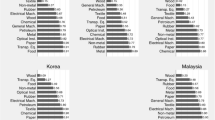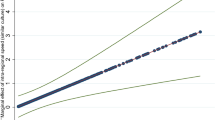Abstract
This study examines how effectively multinational corporations (MNCs) respond to changing external environments by intra-firm shifts of products under the influence of divergent currency changes among countries. We test main hypotheses using a panel dataset of Korean FDI and feasible generalized least square model on STATA 10. We find that more counterpart affiliates with opposite directional exchange rate change, lower transportation costs of product shipping, lower labor cost growth rates, and higher portfolio ownership control are positively associated with the subsidiary’ intra-firm sales. By examining the actual mechanisms whereby MNCs can realize operational flexibility through intra-firm trade among their foreign subsidiaries, this study extends the multinational operational flexibility literature. We show that the magnitude of intra-firm trades within the MNC’s subsidiary network reflects the level of its operational flexibility.
Similar content being viewed by others
Notes
The split sample method does not assume identical unexplained variance between the two split groups (Belderbos and Zou 2009; Hoetker 2007 and thus is considered a more general test for comparing inter-group coefficients. Relevantly, a cross-derivative test allows us to examine whether the moderating effect was positive or negative for all observations, as well as what percentage of the observations was significant (Belderbos and Zou 2009).
References
Aabo, T., & Simkins, B. J. (2005). Interaction between and real options and financial hedging: fact of fiction in managerial decision-making. Review of Financial Economics, 14(3–4), 353–369.
Allen, L., & Pantzalis, C. (1996). Valuation of the operating flexibility of multinational corporations. Journal of International Business Studies, 27(4), 633–653.
Baltagi, B. H., Egger, P., & Pfaffermayr, M. (2007). Estimating models of complex FDI: are there third-country effects? Journal of Econometrics, 140(1), 260–281.
Beck, N., & Katz, J. N. (1995). What to do (and not to do) with time-series cross-section data. American Political Science Review, 89(3), 634–647.
Belderbos, R., & Zou, J. (2009). Real options and foreign affiliate divestments: a portfolio perspective. Journal of International Business Studies, 40(4), 600–620.
Bernard, A. B., Jensen, J. B., & Schott, P. K. (2006). Trade costs, firms, and productivity. Journal of Monetary Economics, 53(5), 917–937.
Buckley, P., & Casson, M. (1976). The future of multinational enterprise. London: McMillan.
Caves, R. E. (1996). Multinational enterprise and economic analysis (2nd ed.). Cambridge: Cambridge University Press.
Cho, K. R. (1990). The role of product-specific factors in intra-firm trade of U.S. manufacturing multinational corporations. Journal of International Business Studies, 21(2), 319–330.
Chung, C. H., Lee, S.-H., Beamish, P., & Isobe, T. (2010). Subsidiary expansion/contraction during times of economic crisis. Journal of International Business Studies, 41(3), 500–525.
Clark, D. P. (2007). Distance, production and trade. Journal of International Trade and Economic Development, 16(3), 359–371.
Cohen, M. A., Fisher, L., & Jaikumar, R. (1989). International manufacturing and distribution networks: a normative model framework. In K. Ferdows (Ed.), Managing International Manufacturing (pp. 67–93). Amsterdam: North-Holland.
Cohen, M. A., & Lee, H. L. (1989). Resource deployment analysis of global manufacturing and distribution networks. Journal of Manufacturing and Operations Management, 2(2), 81–104.
Cuypers, I. R. P., & Martin, X. (2010). What makes and what does not make a real option? A study of international joint ventures. Journal of International Business Studies, 41(1), 47–69.
Delios, A., & Beamish, P. W. (2001). Survival and profitability: the roles of experience and intangible assets in foreign subsidiary performance. Academy of Management Journal, 44(5), 1028–1038.
Faeth, I. (2009). Determinants of foreign direct investment: a tale of nine theoretical models. Journal of Economic Surveys, 23(1), 165–196.
Feinberg, S. E., & Gupta, A. K. (2009). MNC subsidiaries and country risk: internalization as a safeguard against weak external institutions. Academy of Management Journal, 52(2), 381–399.
Fisch, J. H., & Zschoche, M. (2011). Do firms benefit from multinationality through production shifting? Journal of International Management, 17(2), 143–149.
Fisch, J. H., & Zschoche, M. (2012). The effect of operational flexibility on decisions to withdraw from foreign production locations. International Business Review, 21(5), 806–815.
Foley, F. C., Desai, M. A., & Forbes, K. J. (2008). Financial constraints and growth: multinational and local firm responses to currency depreciations. Review of Financial Studies, 21(6), 2857–2888.
Foley, F. C., Desai, M. A., & Hines, J. R. (2007). The internal markets of multinational firms. Survey of Current Business, 87(3), 42–48.
Fujita, M., & Thisse, J. (2006). Globalization and the evolution of the supply chain: who gains and who loses? International Economic Review, 47(3), 811–836.
Goldberg, L. S., & Kolstad, C. D. (1995). Foreign direct investment, exchange rate variability and demand uncertainty. International Economic Review, 36(4), 855–873.
Hamilton, L. C. (2006). Statistics with STATA. Belmont: Brooks/Cole.
Hodder, J. E., & Jucker, J. V. (1985). International plant location under price and exchange rate uncertainty. Engineering and Production Economics, 9(1–3), 225–229.
Hoetker, G. (2007). The use of logit and probit models in strategic management research: critical issues. Strategic Management Journal, 28(4), 331–343.
Huchzermeier, A., & Cohen, M. A. (1996). Valuing operational flexibility under exchange rate risk. Operations Research, 44(1), 100–113.
Jones, R., Keirzkowsik, H., & Lurong, C. (2005). What does evidence tell us about fragmentation and outsourcing? International Review of Economics and Finance, 14(3), 305–316.
Keane, M. P., & Feinberg, S. E. (2007). Advantage in logistics and the growth of intra-firm trade: the case of Canadian affiliates of U. S. multinationals, 1984–1995. Journal of Industrial Economics, 55(4), 571–632.
Kimura, F., & Ando, M. (2005). Two-dimensional fragmentation in East Asia: conceptual framework and empirics. International Review of Economics and Finance, 14(3), 317–348.
Kimura, F., Takahashi, Y., & Hayakawa, K. (2007). Fragmentation and parts and components trade: comparison between East Asia and Europe. North American Journal of Economics and Finance, 18(1), 23–40.
Kiyota, K., Matsuura, T., & Urata, S. (2008). Exchange rate volatility and MNC’s production and distribution networks: the case of Japanese manufacturing MNCs. Singapore Management Review, 53(3), 523–536.
Kobrin, S. J. (1991). An empirical analysis of the determinants of global integration. Strategic Management Journal, 12(S1), 17–32.
Kogut, B. (1991). Joint ventures and the option to expand and acquire. Management Science, 37(1), 19–33.
Kogut, B., & Kulatilaka, N. (1994). Operating flexibility, global manufacturing, and the option value of a multinational network. Management Science, 40(1), 123–139.
Kotabe, M., & Murray, J. (1990). Linking product and process innovations and modes of international sourcing in global competition: a case of foreign multinational firms. Journal of International Business Studies, 21(3), 383–408.
Kotabe, M., & Omura, G. (1989). Sourcing strategies of European and Japanese multinationals: a comparison. Journal of International Business Studies, 20(1), 113–130.
Lee, S.-H., & Makhija, M. (2009a). Flexibility in internationalization: is it valuable during an economic crisis? Strategic Management Journal, 30(5), 537–555.
Lee, S.-H., & Makhija, M. (2009b). The effect of domestic uncertainty on the real options value of international investments. Journal of International Business Studies, 40(3), 405–420.
Lee, S.-H., Makhija, M., & Paik, Y. (2008). The value of real options investments under abnormal uncertainty: the case of the Korean economic crisis. Journal of World Business, 43(1), 16–34.
Lee, S.-H., & Song, S. (2012). Host country uncertainty, inter-MNC subsidiary shift of production, and foreign subsidiary performance. Strategic Management Journal, 33(11), 1331–1340.
Makhija, M. K., Kim, S., & Williamson, S. D. (1997). Measuring globalization of industries using a national approach: empirical evidence across five countries and over time. Journal of International Business Studies, 28(4), 679–710.
Martinez-Zarzoso, I., & Nowak-Lehmann, F. (2007). Is distance a good proxy for transport costs? The case of competing transport modes. Journal of International Trade and Economic Development, 16(3), 411–434.
Mauri, A., & Phatak, A. V. (2001). Global integration as inter-area product flows: the internalization of ownership and location factors influencing product flows across MNC units. Management International Review, 41(3), 233–249.
Miller, K. D., & Reuer, J. J. (1998). Firm strategy and economic exposure to foreign exchange rate movements. Journal of International Business Studies, 29(3), 493–514.
Mol, J., Pauwels, P., Matthyssens, P., & Quintens, L. (2004). A technological contingency perspective on the depth and scope of international outsourcing. Journal of International Management, 10(2), 287–305.
Monteiro, L. F., Arvidson, N., & Birkinshaw, J. (2008). Knowledge flows within multinational corporations: explaining subsidiary isolation and its performance implication. Organization Science, 19(1), 90–107.
Munroe, D. K., Hewings, G. J. D., & Guo, D. (2007). The role of intraindustry trade in interregional trade in the midwest of the US. In R. Cooper et al. (Eds.), Advances in Spatial Science (pp. 87–105). Heidelberg: Springer.
Padmanabhan, P., & Cho, K. R. (1999). Decision specific experience in foreign ownership and establishment strategies: evidence from Japanese firms. Journal of International Business Studies, 30(1), 25–43.
Pan, Y. (2002). Equity ownership in international joint ventures: the impact of source country factors. Journal of International Business Studies, 33(2), 375–384.
Pantzalis, C., Simkins, B. J., & Laux, P. (2001). Operational hedges and the foreign exchange exposure of U.S. multinational corporations. Journal of International Business Studies, 32(4), 793–812.
Park, H. (2000). Foreign direct investment and global sourcing choices of firms in the US. Managerial and Decision Economics, 21(6), 211–221.
Rangan, S. (1994). Are transnational corporations an impediment to trade adjustment? Transnational Corporation, 3(3), 52–80.
Rangan, S. (1998). Do multinationals operate flexibly? Theory and evidence. Journal of International Business Studies, 29(2), 217–237.
Reuer, J. J., & Leiblein, M. J. (2000). Downside risk implications of multi-nationality and international joint ventures. Academy of Management Journal, 43(2), 203–214.
Rycroft, R. W. (2003). Technology-based globalization indicators: the centrality of innovation network data. Technology in Society, 25(3), 299–317.
Tang, L. (2003). The relative efficiency of ownership structures and intra-firm trade. The International Trade Journal, 17(2), 177–203.
Tang, C., & Tikoo, S. (1999). Operational flexibility and market valuation of earnings. Strategic Management Journal, 20(8), 749–761.
Tong, T., & Reuer, J. J. (2007). Switching options and coordination costs in multinational firms. Journal of International Business Studies, 38(2), 215–230.
Willmore, L. (1992). Transnationals and foreign trade: evidence from Brazil. Journal of Development Studies, 28(2), 314–335.
Xing, Y. (2007). Foreign direct investment and China’s bilateral intra-industry trade with Japan and the US. Journal of Asian Economics, 18(4), 685–700.
Author information
Authors and Affiliations
Corresponding author
Rights and permissions
About this article
Cite this article
Song, S. Inter-Country Exchange Rates and Intra-Firm Trade Flow Within Global Network of Multinational Corporations. Manag Int Rev 55, 1–22 (2015). https://doi.org/10.1007/s11575-014-0233-4
Received:
Revised:
Accepted:
Published:
Issue Date:
DOI: https://doi.org/10.1007/s11575-014-0233-4




